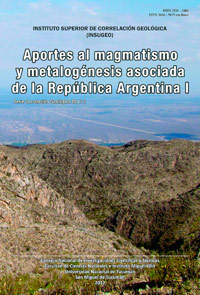Serie Correlación Geológica 28 (1)
Depósitos epitermales de baja sulfuración ricos en sulfuros de metales base, distrito aurífero La Carolina, San Luis, Argentina
María Cecilia Gallard-Esquivel | María Silvia Japas | Patricia Sruoga | Nilda Esther Urbina
Descargar trabajo en formato PDFResumen
El distrito aurífero La Carolina se halla en el extremo occidental de la Faja Metalogenética de San Luis, la cual está espacial y genéticamente vinculada al volcanismo mesosilícico mioplioceno. La ubicación de esta faja es consecuencia de la migración hacia el este del arco volcánico debido a la horizontalización de la Placa de Nazca entre los 27°-33° LS, conocido como el segmento de Flat-Slab Pampeana. La actividad volcánica en el distrito comenzó a los 8,2 Ma y finalizó a los 6,3 Ma. Comprende lavas y piroclastitas de composición andesítica, dacítica, lacítica y traquítica. Los magmas mesosilícicos pertenecen a las suites calcoalcalina normal y de alto K hasta shoshonítica. El análisis estructural muestra que las estructuras antiguas controlaron fuertemente el emplazamiento de las rocas volcánicas y depósitos minerales asociados, como así también, ha permitido reconocer la existencia de una estructura principal de tipo pull apart. En dicho distrito existen ocho pequeños prospectos mineralizados. La mineralogía consiste de pirita, pirita-arsenical, galena, esfalerita, marcasita, melnikovita, calcopirita, pirrotina, arsenopirita, tennantita-tetrahedrita, pirargirita, hessita, silvanita, pearceita, argirodita, oro, plata, greigita, boulangerita, jamesonita y electrum. La ganga es cuarzo, calcita, calcedonia y adularia subordinada. La alteración hidrotermal comprende sericita, illita, illita/ esmectita, silicificación y alteración propilítica. Estudios de inclusiones fluidas indican que el rango de temperatura de formación varía entre 230°-330°C. En base a la mineralogía, texturas, alteración hidrotermal, temperaturas de formación, química de los fluidos y geoquímica prospectiva las manifestaciones minerales han sido clasificadas como depósitos epitermales de baja sulfuración ricos en sulfuros de metales base.
Abstract
LOW-SULFIDATION EPITHERMAL BASE-METAL SULFIDE-RICH DEPOSITS, LA CAROLINA GOLD-BEARING DISTRICT, SAN LUIS, ARGENTINA. La Carolina gold-bearing district is located at the western end of the Metallogenetic Belt of San Luis, which is spatially and genetically related to the mesosilicic volcanism of mio-pliocene age. The volcanic arc experienced an eastward migration, due to the flattening of the Nazca plate in the segment 27°-33°S, known as the Pampean flat-slab. At La Carolina, the volcanic activity occurred between 8.2 and 6.3 Ma. It encompasses lavas and pyroclastics of andesitic, dacitic, latitic and trachytic composition. The mesosilicic magmas belong to normal to high-k calc-alkaline and shoshonitic suites. Structural analysis shows that previous structures have strongly controlled the emplacement of volcanic rocks and related mineral deposits at La Carolina allowing to define a pullapart. In this gold-bearing district there are eigth small mineralized prospects. The mineralogy consists of pyrite, arsenic rich pyrite, galena, sphalerite, marcasite, melnikovite, chalcopyrite, pyrrhotite, arsenopyrite, tennantitetetrahedrite, digenite, covellite, bornite, pyrargiryte, hessite, silvanite, pearceite, argirodite, gold, silver, greigite, boulangerite, jamesonite and electrum. The gangue consists of quartz, calcite, chalcedony and minor adularia. The hydrothermal alteration is widespread and comprise phyllic and argillic mineral assemblages characterized by sericite, illite, interstratified I/S, and silicic; propylitic alteration is also present as an outer halo. Fluid inclusions studies show that the formation temperatures range between 230º to 330º C. Boiling and mixing with meteoric water led to mineral precipitation. Based on the mineralogy, textures, hydrothermal alteration, formation temperatures, fluid chemistry and prospective geochemistry the mineralizations have been classified as low-sulfidation epithermal base-metal sulfide-rich deposits.






